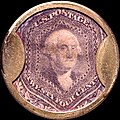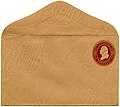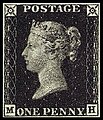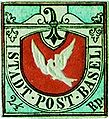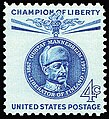Portal:Philately
| Philately portal | WikiProject Philately |
The Philately Portal
Philately is the study of revenue or postage stamps. This includes the design, production, and uses of stamps after they are issued. A postage stamp is evidence of pre-paying a fee for postal services. Postal history is the study of postal systems of the past. It includes the study of rates charged, routes followed, and special handling of letters.
Stamp collecting is the collecting of postage stamps and related objects, such as covers (envelopes, postcards or parcels with stamps affixed). It is one of the world's most popular hobbies, with estimates of the number of collectors ranging up to 20 million in the United States alone.

The state communications in the Neo-Assyrian Empire allowed the Assyrian king and his officials to send and receive messages across the empire quickly and reliably. Messages were sent using a relay system (Assyrian: kalliu) which was revolutionary for the early first millennium BCE. Messages were carried by military riders who travelled on mules. At intervals the riders stopped at purpose-built stations, and the messages were passed to other riders with fresh mounts. The stations were positioned at regular intervals along the imperial highway system. Because messages could be transmitted without delay and without waiting for riders to rest, the system provided unprecedented communication speed, which was not surpassed in the Middle East until the introduction of the telegraph.
The efficiency of the system contributed to the Neo-Assyrian Empire's dominance in the Middle East and to maintaining cohesion throughout the empire. These Assyrian innovations were adopted by later empires, including the Achaemenid Empire which inherited and expanded the Assyrian communication network. (Full article...)Selected article -
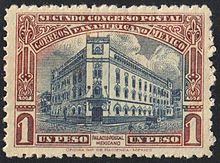
The Mexican postal system has its roots in the Aztec system of messengers which the Spanish adopted after the Conquest. A postal service was established in 1580, mainly to communicate between the viceroyalty of New Spain with the motherland Spain. During the 18th century, Spain established a formal postal system with regular routes. In 1856, Mexico issued its first adhesive postage stamps, with "district overprints", a unique feature among postal systems worldwide, employed to protect from theft of postage stamps.
In 1891, the postal and stamp issuing authority was created as an administrative division of the Secretaría de Comunicaciones (Secretariat of Communications). It was called Servicio Postal Mexicano (Sepomex). In 1901, the Dirección General de Correos (General Direction of Mail) was made a separate government agency. The Palacio de Correos de Mexico is used since 1907 as main post office. (Full article...)Selected images
Did you know (auto-generated)

- ... that after the British Army captured New York City in 1776, Samuel Loudon fled to the village of Fishkill, where he founded the state's first post office?
- ... that both of Karl R. Free's New Deal-era U.S. post office murals with Native American subjects have been challenged as offensive?
- ... that Argentinian Ricardo D. Eliçabe qualified as a physician, co-founded a petroleum refinery, and wrote about forgeries of Bolivia's first stamps?
- ... that Amrita Sher-Gil's painting Hill Women appeared on a 1978 Indian postage stamp?
- ... that in 1850, about a quarter of the post offices of the Swiss Post were located in taverns?
- ... that in 2007, Arthur Gray's £2 Kangaroo and Map stamp sold for a world record price for a single Australian stamp?
General images -
Selected stamp -

1852 red sealing wafer Scinde Dawk stamp (Full article...)
List articles

- List of philatelists
- List of most expensive philatelic items
- List of postage stamps
- Lists of people on postage stamps (article) • (Category page)
- List of entities that have issued postage stamps (A–E)
- List of entities that have issued postage stamps (F–L)
- List of entities that have issued postage stamps (M–Z)
- List of postal services abroad
- Timeline of postal history
Related portals
Topics
Categories
WikiProject
![]() WikiProject Philately organizes the development of articles relating to philately. For those who want to skip ahead to the smaller articles, the WikiProject also maintains a list of articles in need of improvement or that need to be started. There are also many red inked topics that need to be started on the list of philatelic topics page.
WikiProject Philately organizes the development of articles relating to philately. For those who want to skip ahead to the smaller articles, the WikiProject also maintains a list of articles in need of improvement or that need to be started. There are also many red inked topics that need to be started on the list of philatelic topics page.
Selected works
- Williams, Louis N., & Williams, Maurice (1990). Fundamentals of Philately {revised ed.). American Philatelic Society. ISBN 0-9335-8013-4.
{{cite book}}: CS1 maint: multiple names: authors list (link) - Hornung, Otto (1970). The Illustrated Encyclopedia of Stamp Collecting. Hamlyn. ISBN 0-600-01797-4.
- Stuart Rossiter & John Fowler (1991). World History Stamp Atlas (reprint ed.). pub: Black Cat. ISBN 0-7481-0309-0.
Wikimedia
The following Wikimedia Foundation sister projects provide more on this subject:
-
Commons
Free media repository -
Wikibooks
Free textbooks and manuals -
Wikidata
Free knowledge base -
Wikinews
Free-content news -
Wikiquote
Collection of quotations -
Wikisource
Free-content library -
Wikiversity
Free learning tools
Other Portals
Sources
- ^ "Philatelic Collections: General Collections". British Library. 2003-11-30. Archived from the original on 30 June 2011. Retrieved 2011-01-16.



![Image 1Unissued 1956 £1 Jamaican chocolate and violet, the first stamp designed for Queen Elizabeth II. Held in the British Library Crown Agents Collection.[1]](http://upload.wikimedia.org/wikipedia/commons/thumb/9/9b/Stamp_Jamaica_1956_unissued_1sh.jpg/120px-Stamp_Jamaica_1956_unissued_1sh.jpg)





